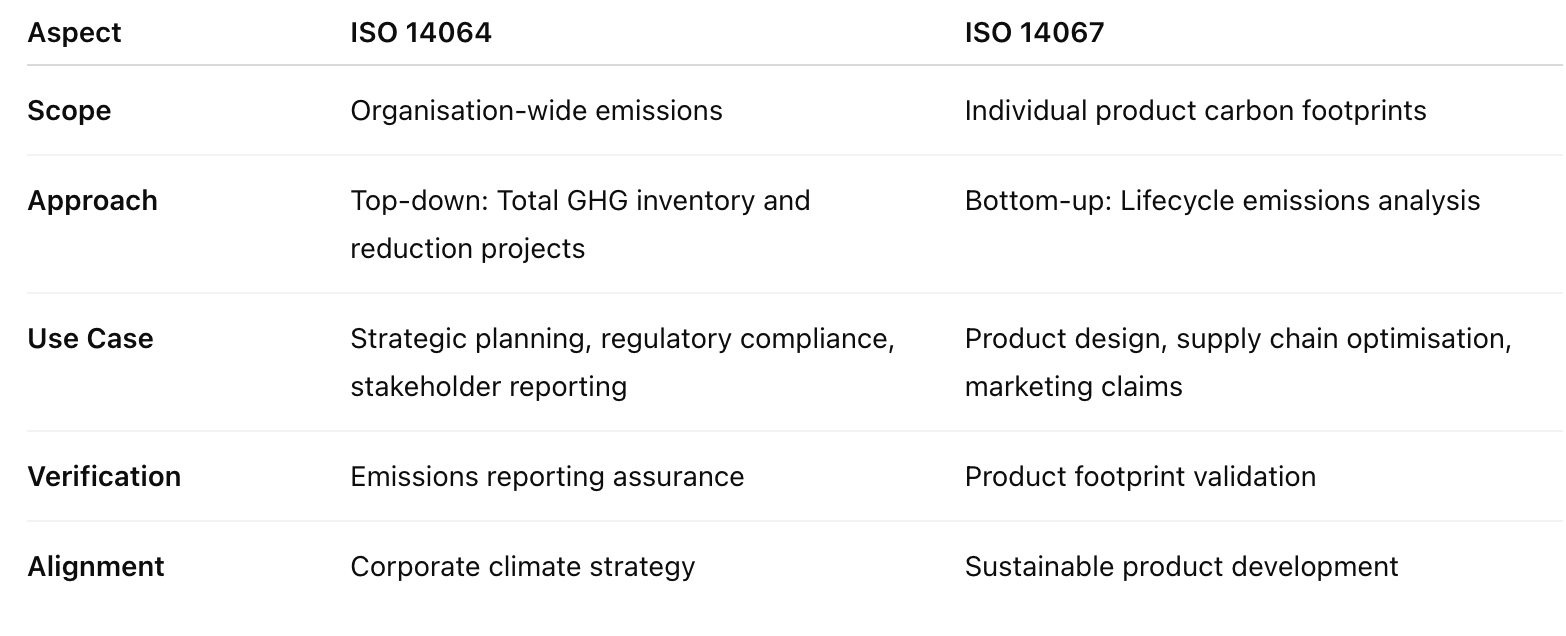When it comes to environmental reporting, consistency is essential. Imagine trying to compare the carbon footprint of a textile manufacturer in Manchester with a tech startup in Melbourne. Without a shared framework, you’re not just comparing apples to oranges; you’re comparing apples to satellites.
This is where the International Organisation for Standardisation (ISO) steps in. With its globally recognised standards, ISO provides the much-needed structure for organisations to measure, report, and reduce greenhouse gas (GHG) emissions in a consistent, credible way.
Two of the most important standards in this space are ISO 14064 and ISO 14067. While they’re often mentioned together, they serve very different purposes. Let’s break down what each standard covers, how they differ, and why both are becoming critical tools for sustainability leaders.
ISO 14064: A Panoramic View of Organisational Emissions
Think of ISO 14064 as a comprehensive health check for your organisation’s carbon impact. Instead of looking at a single activity or product, it maps your entire carbon ecosystem, capturing emissions across operations, supply chains, and reduction projects. The standard is split into three parts:
- ISO 14064-1: Helps organisations quantify and report their total GHG emissions and removals across Scope 1, 2, and (optionally) 3.
- ISO 14064-2: Focuses on specific emissions reduction projects, outlining how to quantify and document carbon savings from targeted activities.
- ISO 14064-3: Sets out verification and validation processes to ensure reported data is robust, credible, and ready for external assurance.
Why It Matters
ISO 14064 transforms carbon reporting from a compliance box-ticking exercise into a strategic decision-making tool. It enables companies to:
- Identify and address emissions hotspots
- Align with global climate disclosure requirements
- Track progress toward net zero goals
- Communicate performance transparently to investors, regulators, and stakeholders
ISO 14067: Zooming In on Product Carbon Footprints
While ISO 14064 looks at the organisation as a whole, ISO 14067 is a magnifying glass. It dives deep into the carbon footprint of a single product, accounting for emissions across its entire lifecycle, from raw material extraction to manufacturing, distribution, use, and end-of-life. Whether it’s a bottle of juice or a pair of running shoes, ISO 14067 helps businesses answer the question: What is the real environmental cost of making and delivering this product?
Why It Matters
ISO 14067 is increasingly used to:
- Calculate product carbon footprints using lifecycle assessment (LCA) principles
- Improve product design and sourcing decisions based on emissions insights
- Support carbon labelling initiatives and sustainability claims
- Increase supply chain transparency and prepare for product-level regulations
ISO 14064 vs ISO 14067: Key Differences at a Glance

While both standards rely on rigorous methodology, transparent reporting, and verifiable data, their perspectives are different. ISO 14064 takes a wide-angle view of your entire business, while ISO 14067 is more like a microscope focused on a single item. Together, they offer a powerful toolkit for managing emissions holistically, from boardroom strategy to product shelf.
Real-World Applications: Why These Standards Matter Now
As expectations around corporate sustainability continue to grow, so does the need for credible data. Whether you’re reporting to investors, preparing for upcoming regulations, or communicating with climate-conscious customers, ISO standards provide a trustworthy foundation.
For Businesses:
- Meet global climate disclosure requirements (e.g. CSRD, SGX)
- Pinpoint emissions hotspots across operations and supply chains
- Inform and validate decarbonisation strategies
- Gain third-party assurance and improve ESG ratings
For Products:
- Identify high-impact materials or processes during product development
- Benchmark and reduce the carbon footprint of specific SKUs
- Enable product-level transparency and build customer trust
- Lay the groundwork for credible carbon labels and ecolabel schemes
For Consumers and Stakeholders:
- Access clear, comparable information about product emissions
- Make more informed purchasing and investment decisions
- Differentiate between genuine action and greenwashing
Implementing ISO Standards: Challenges and Opportunities
Adopting ISO 14064 or ISO 14067 is not a plug-and-play exercise. It requires thoughtful planning, internal alignment, and often a cultural shift toward data-driven sustainability. One of the first hurdles many organisations face is building reliable data systems that can accurately track and categorise emissions across scopes or product lifecycles. Without the right infrastructure, measurement becomes patchy at best and misleading at worst.
There’s also a learning curve. Teams must be trained to understand carbon accounting principles, whether that means calculating emissions across an organisation or conducting product-level lifecycle assessments. And as sustainability reporting increasingly moves toward third-party assurance, companies must be prepared to meet the rigorous demands of external verification.
On the other hand, implementing these standards brings new visibility into your operations, surfacing inefficiencies and emissions hotspots that would otherwise go unnoticed. It enables clearer, more credible communication with customers, investors, and regulators. And it positions your organisation as forward-thinking and ready to lead, not just comply, in a carbon-conscious economy. Ultimately, ISO 14064 and ISO 14067 both serve as a framework for progress, helping companies take steps to turn climate ambition into meaningful and measurable action.
Looking Ahead: The Future of Carbon Measurement
As ESG reporting expectations evolve and product-level regulations tighten, both ISO 14064 and ISO 14067 will become essential tools for sustainability, innovation, and resilience. Whether you're just starting your net zero journey or scaling up your strategy, these standards serve as a framework for progress, providing a clear roadmap to turn climate ambition into measurable action.
Zevero helps organisations implement carbon standards like ISO 14064 and ISO 14067 by providing the tools, data, and expert support to turn emissions data into action. Talk to our team to see how we can help guide your business through meeting these standards.


.jpg)


